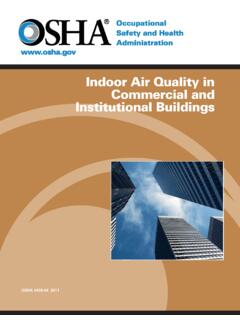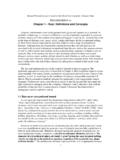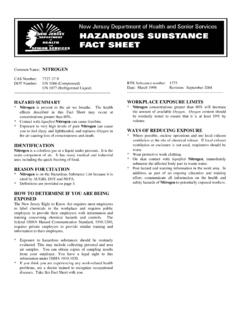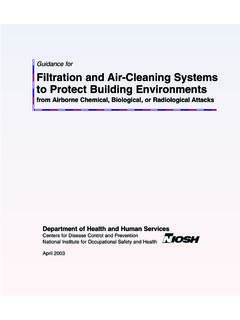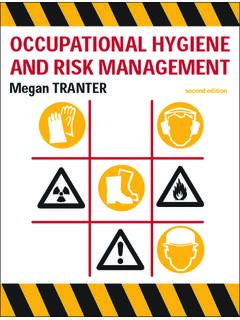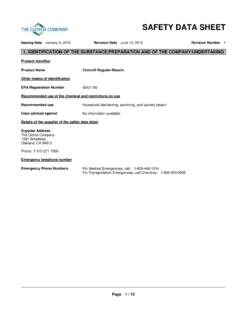Transcription of Hydrochloric Acid (Hydrogen Chloride)
1 Hydrochloric Acid (Hydrogen Chloride) 7647-01-0 Hazard Summary-Created in April 1992; Revised in January 2000 Hydrochloric acid has many uses. It is used in the production of chlorides, fertilizers, and dyes, inelectroplating, and in the photographic, textile, and rubber industries. Hydrochloric acid is corrosive to theeyes, skin, and mucous membranes. Acute (short-term) inhalation exposure may cause eye, nose, andrespiratory tract irritation and inflammation and pulmonary edema in humans. Acute oral exposure maycause corrosion of the mucous membranes, esophagus, and stomach and dermal contact may producesevere burns, ulceration, and scarring in humans.
2 Chronic (long-term) occupational exposure tohydrochloric acid has been reported to cause gastritis, chronic bronchitis, dermatitis, andphotosensitization in workers. Prolonged exposure to low concentrations may also cause dentaldiscoloration and erosion. EPA has not classified Hydrochloric acid for Note: The main source of information for this fact sheet is EPA's Integrated Risk Information System (IRIS) (4), which contains information on inhalation chronic toxicity of Hydrochloric acid and the Reference Concentration(RfC). Other secondary sources include the Hazardous Substances Data Bank (HSDB) (1), a database of summaries of peer-reviewed literature, and the Registry of Toxic Effects of Chemical Substances (RTECS) (5)
3 , a database of toxic effects that are not peer acid is used in the production of chlorides, for refining ore in the production of tin andtantalum, for pickling and cleaning of metal products, in electroplating, in removing scale from boilers, forthe neutralization of basic systems, as a laboratory reagent, as a catalyst and solvent in organic syntheses,in the manufacture of fertilizers and dyes, for hydrolyzing starch and proteins in the preparation of variousfood products, and in the photographic, textile, and rubber industries. (1-4,6)Sources and Potential ExposureOccupational exposure to Hydrochloric acid may occur via inhalation or dermal contact during itsproduction and use.
4 (1,2)Assessing Personal ExposureNo information was located regarding the measurement of personal exposure to Hydrochloric Hazard InformationAcute Effects: Hydrochloric acid is corrosive to the eyes, skin, and mucous membranes. Acute inhalation exposure maycause coughing, hoarseness, inflammation and ulceration of the respiratory tract, chest pain, andpulmonary edema in humans. (1-4)Acute oral exposure may cause corrosion of the mucous membranes, esophagus, and stomach, withnausea, vomiting, and diarrhea reported in humans. Dermal contact may produce severe burns, ulceration,and scarring. (1-4)and scarring. (1-4)Pulmonary irritation, lesions of the upper respiratory tract, and laryngeal and pulmonary edema have beenreported in rodents acutely exposed by inhalation.
5 (1,4)Acute animal tests in rats, mice, and rabbits, have demonstrated Hydrochloric acid tohave moderate to high acute toxicity from inhalation and moderate acute toxicity from oral exposure. (3)Chronic Effects (Noncancer):Chronic occupational exposure to Hydrochloric acid has been reported to cause gastritis, chronicbronchitis, dermatitis, and photosensitization in workers. Prolonged exposure to low concentrations mayalso cause dental discoloration and erosion. (1-3,6)Chronic inhalation exposure caused hyperplasia of the nasal mucosa, larynx, and trachea and lesions in thenasal cavity in rats. (4,6)The Reference Concentration (RfC) for Hydrochloric acid is milligrams per cubic meter (mg/m3) basedon hyperplasia of the nasal mucosa, larynx, and trachea in rats.
6 The RfC is an estimate (with uncertaintyspanning perhaps an order of magnitude) of a continuous inhalation exposure to the human population(including sensitive subgroups) that is likely to be without appreciable risk of deleterious noncancer effectsduring a lifetime. It is not a direct estimator of risk but rather a reference point to gauge the potentialeffects. At exposures increasingly greater than the RfC, the potential for adverse health effects increases. Lifetime exposure above the RfC does not imply that an adverse health effect would necessarily occur. (4)EPA has low confidence in the study on which the RfC was based since it used only one dose and hadlimited toxicological measurements; low confidence in the database because the database does not provideany additional chronic or reproductive studies; and, consequently, low confidence in the RfC.
7 (4)EPA has not established a Reference Dose (RfD) for Hydrochloric acid. (4)Reproductive/Developmental Effects:No information is available on the reproductive or developmental effects of Hydrochloric acid in rats exposed to Hydrochloric acid by inhalation, severe dyspnea, cyanosis, and altered estrus cycles havebeen reported in dams, and increased fetal mortality and decreased fetal weight have been reported in theoffspring. (4,6)Cancer Risk:No information is available on the carcinogenic effects of Hydrochloric acid in one study, no carcinogenic response was observed in rats exposed via inhalation. (1)EPA has not classified Hydrochloric acid with respect to potential carcinogenicity.
8 (4)Physical PropertiesHydrogen chloride is a common synonym for Hydrochloric acid. (4)The chemical formula for Hydrochloric acid is HCl, and its molecular weight is g/mol. (1,3) Hydrochloric acid occurs as a colorless, nonflammable aqueous solution or gas. (1,3,4) Hydrochloric acid has an irritating, pungent odor, with an odor threshold of about 7 mg/m3. (1)Conversion Factors: To convert concentrations in air (at 25 C) from ppm to mg/m3: mg/m3 = (ppm) (molecular weight of thecompound)/( ). For Hydrochloric acid: 1 ppm = Data from Inhalation ExposureAIHA ERPG--American Industrial Hygiene Association's emergency response planning guidelines.
9 ERPG 1 is themaximum airborne concentration below which it is believed nearly all individuals could be exposed up to one hourwithout experiencing other than mild transient adverse health effects or perceiving a clearly defined objectionableodor; ERPG 2 is the maximum airborne concentration below which it is believed nearly all individuals could beexposed up to one hour without experiencing or developing irreversible or other serious health effects that couldimpair their abilities to take protective action. ACGIH TLV ceiling--American Conference of Governmental and Industrial Hygienists' threshold limit value ceiling;the concentration of a substance that should not be exceeded during any part of the working exposure.
10 LC50 (Lethal Concentration50)--A calculated concentration of a chemical in air to which exposure for a specificlength of time is expected to cause death in 50% of a defined experimental animal population. LOAEL--Lowest-observed-adverse-effect level. NIOSH REL ceiling--National Institute of occupational Safety and health 's recommended exposure limit ceiling; theconcentration that should not be exceeded at any time. NIOSH IDLH -- NIOSH's immediately dangerous to life or health concentration; NIOSH recommended exposure limitto ensure that a worker can escape from an exposure condition that is likely to cause death or immediate ordelayed permanent adverse health effects or prevent escape from the environment.










